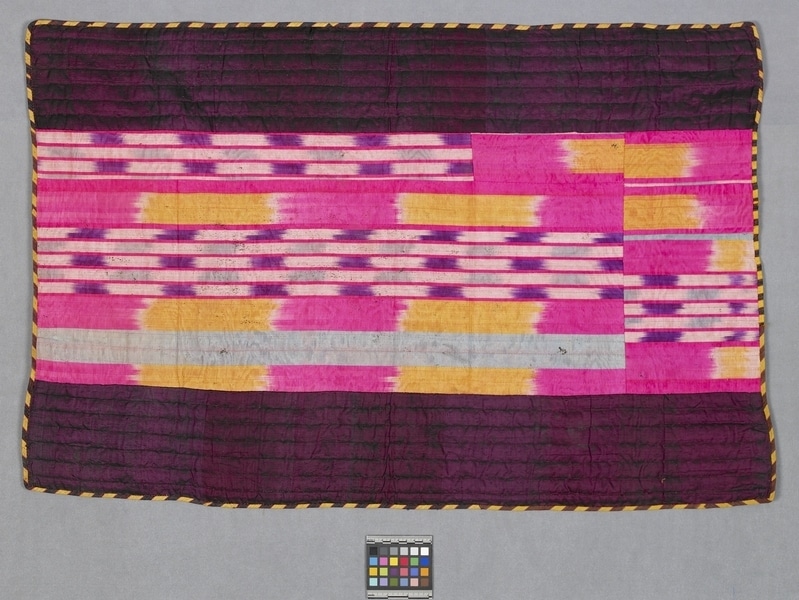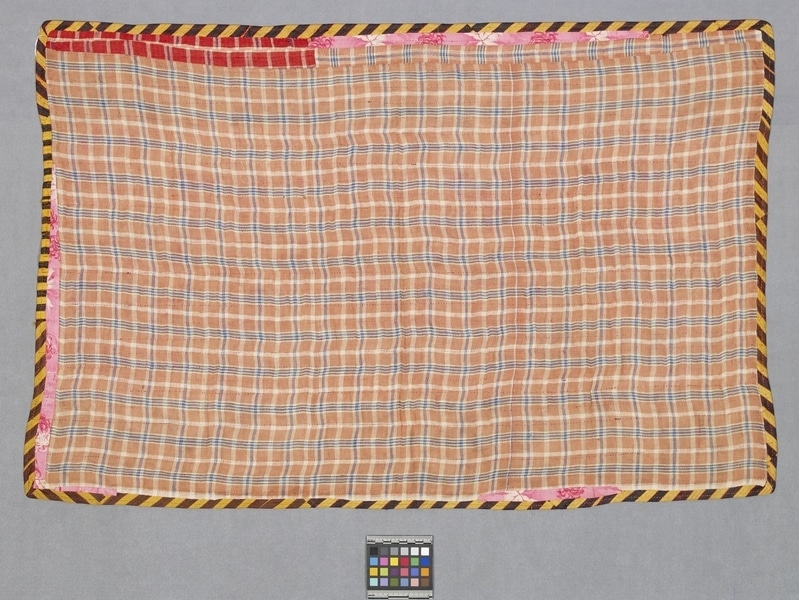Textile Item Number: 915/6 from the MOA: University of British Columbia


Description
Wall hanging or bed cover, consisting of three panels. A centre panel of multi-coloured warp-face silk and cotton ikat textile is flanked on either side by panels of dark red-purple shot silk taffeta. The designs on the ikat panel are simple, geometric and linear blocks of colour (predominantly pink, yellow, purple and blue), and the textile has a shiny, glazed surface. The piece is hand quilted with red thread and is lined with cotton gauze, which has a woven plaid pattern in pale blue, tan and white and is pieced along some edges with pink and red cotton textile. The edges are bound with bias strips of yellow and purple striped silk (or cotton and silk) textile.
History Of Use
May have been used as a bed cover (adiol) for a bride and groom, or could also have been used as a decorative wall hanging (pardah), curtain, room divider, etc. The production of ikat silks, which reached its peak in the 19c and declined rapidly in the early 20c, was a commercial venture, carried out primarily in urban centres, such as Bukhara, Samarkand and Marghilan in the Ferghana Valley by various ethnic groups, such as Uzbeks, Turkmen and Tadjiks. Woven silks were widely distributed throughout Central Asia and were sold in local bazaars. The varied tasks required in the complex dying and weaving of ikat textiles were traditionally assigned to specific ethnic groups. For instance, Jews traditionally were assigned the task of ‘cold dying’ with indigo. The cultivation of silk was women’s work, done in the home. Dying and weaving were done by men; women could not work outside the home. The lives of Central Asian women therefore centred around the home, where colourful, lavish textiles played a major role in the rituals of daily life. The use of cotton in the production of the ikat textiles used in this piece indicates that it was produced for a family of lower social status. The wearing and use of pure silk textiles were regulated by a strict code of conduct. Only persons of the highest rank could wear pure silk ikat. Persons of lower rank could, however, wear ikats made with patterned silk warp, but woven with cotton weft, as is used in the object. These textiles are called adras. The cotton weft forms a subtle horizontal ribbed effect that is easily recognizable.
Specific Techniques
The sheen on the adras textile is made by applying a solution containing egg whites; the textile is then beaten with wooden mallets and pressed between flat stones to produce a shiny surface.
Narrative
According to Clarke Abbott of Tradewind Antiques, the person who collected this piece lived in Kabul in the early 1960s, doing ambassadorial work. He traveled widely throughout the area. He was killed in an automobile accident there, and no further information is available about him or his collection. The piece was subsequently acquired by Tradewind Antiques in Vancouver at an unknown date, and the Museum of Anthropology purchased it in 1984, when the business was liquidating its stock.
Item History
- Made in Afghanistan ? or Uzbekistan ?
- Collected in Afghanistan ?
- Owned by Tradewind Antiques before January 10, 1984
- Received from Museum of Anthropology Shop Volunteers (Funding source) and Tradewind Antiques (Seller) on January 10, 1984
What
- Name
- Textile
- Identification Number
- 915/6
- Type of Item
- textile
- Material
- silk fibre, cotton fibre and dye
- Manufacturing Technique
- warp face ikat
- Overall
- height 0.3 cm, width 94.0 cm, depth 61.0 cm
Who
- Culture
- Turkmen ? or Uzbek ?
- Previous Owner
- Tradewind Antiques
- Received from
- Museum of Anthropology Shop Volunteers (Funding source) and Tradewind Antiques (Seller)
Where
- Holding Institution
- MOA: University of British Columbia
- Made in
- Afghanistan ? or Uzbekistan ?
- Collected in
- Afghanistan ?
When
- Ownership Date
- before January 10, 1984
- Acquisition Date
- on January 10, 1984
Other
- Item Classes
- textiles
- Condition
- good
- Accession Number
- 0915/0006